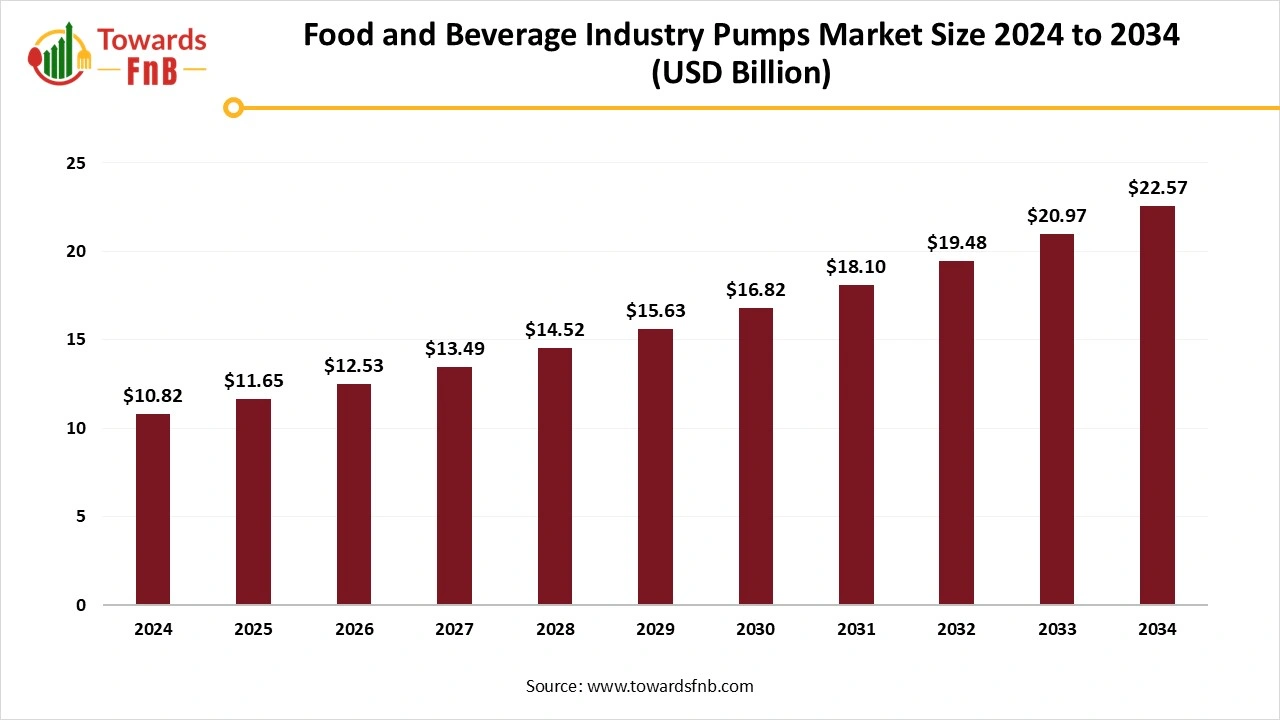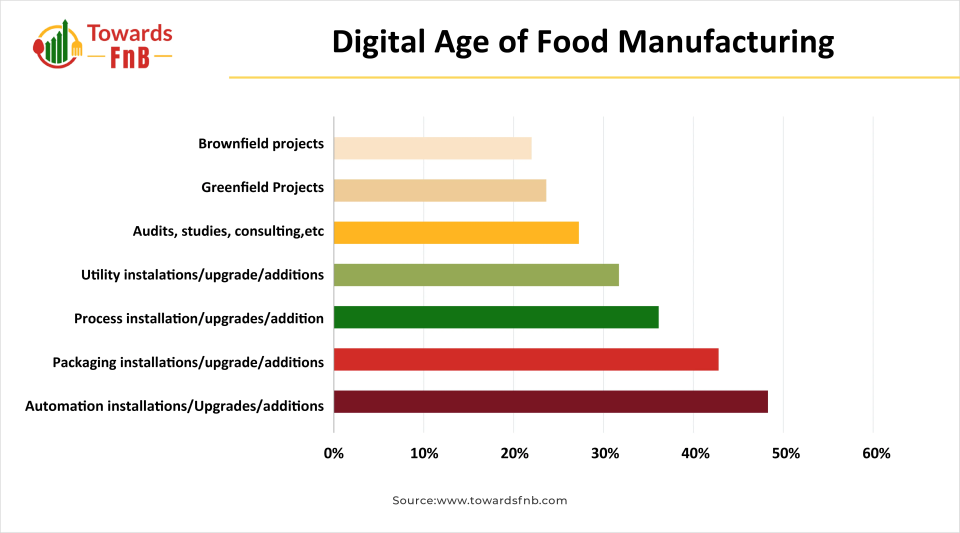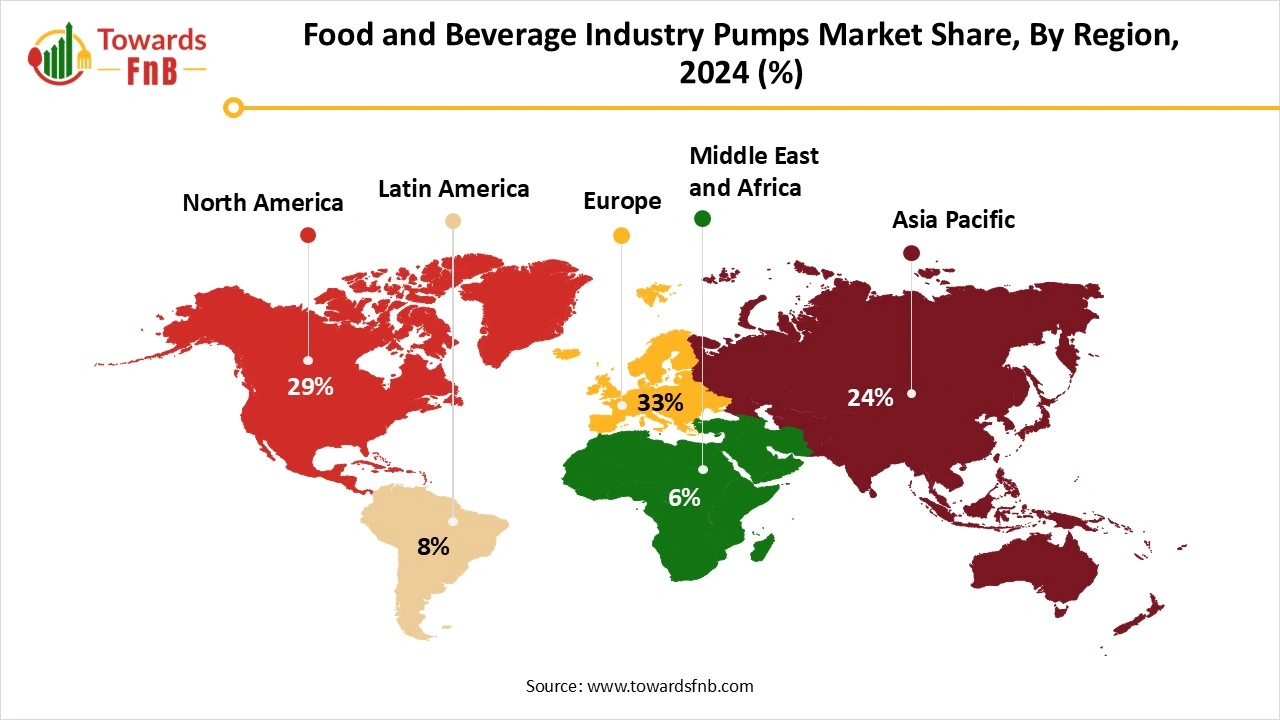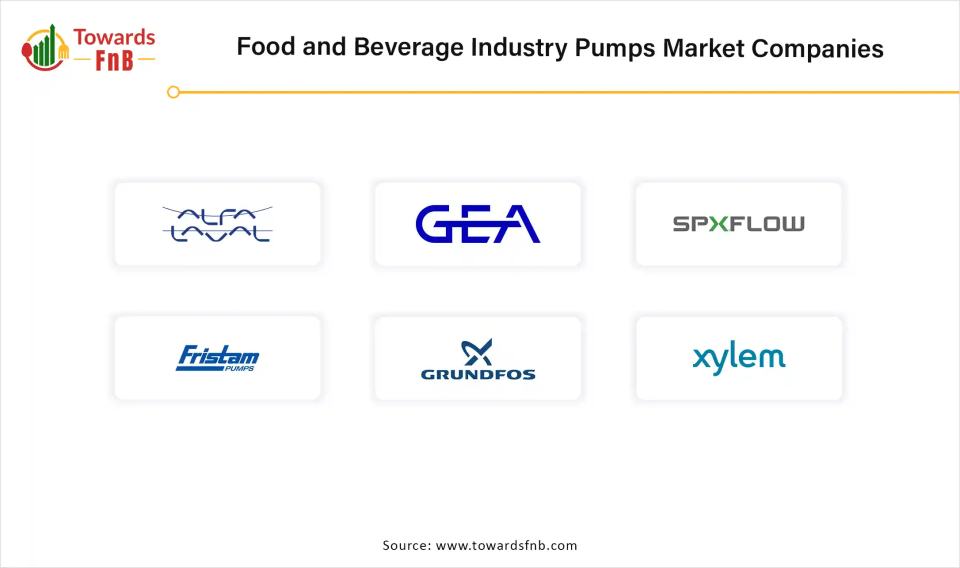November 2025
The global food and beverage industry pumps market size was valued at USD 10.82 billion in 2024 and is expected to grow steadily from USD 11.65 billion in 2025 to reach nearly USD 22.57 billion by 2034, with a CAGR of 7.63% during the forecast period from 2025 to 2034. The increased need for hygiene, maintenance of product integrity, and efficient handling of various types of products manufactured in the food and beverage industries raises the importance of a versatile range of industrial pumps.

| Study Coverage | Details |
| Growth Rate from 2025 to 2034 | CAGR of 7.63% |
| Market Size in 2025 | USD 11.65 Billion |
| Market Size in 2026 | USD 12.53 Billion |
| Market Size by 2034 | USD 22.57 Billion |
| Largest Market | Europe |
| Base Year | 2024 |
| Forecast Period | 2025 to 2034 |
| Regions Covered | North America, Europe, Asia-Pacific, Latin America, and Middle East & Africa |
The food and beverage industry pumps market encompasses the range of pumps and fluid handling systems used throughout the production, processing, and packaging stages in the food and beverage sector. These pumps are engineered to meet stringent hygiene, safety, and efficiency standards while handling products of varying viscosities, temperatures, and particulate contents. They are critical in applications such as transferring dairy, beverages, sauces, syrups, oils, and other ingredients in compliance with food-grade certifications (e.g., 3-A, EHEDG, FDA). As demand rises for automation, clean-in-place (CIP) systems, and energy-efficient equipment, the pump market plays a pivotal role in ensuring safe, consistent, and scalable food and beverage manufacturing.
The food and beverage industries are leveraging AI, automation, and industry 4.0 for food manufacturing. According to one of the 2024 surveys by CRB Group, about 48% of capital spending is dedicated to automation projects, 70% of F&B industries see automation as the top benefit for productivity, and 78% of F&B industries utilize automation to stay competitive amid labor shortages. This survey stated that about 37% of F&B industries have already adopted technological integration, including predictive analytics and real-time analytics within their food processing plants. It has also revealed that productivity remains the primary benefit of automation and industry 4.0.
How does the Food and Beverage Industry Utilize AI, Automation, and Industry 4.0?
 (Source: CRB group)
(Source: CRB group)
How Europe Dominated the Food & Beverage Industry Pumps Market in 2024?
Europe dominated the food & beverage industry pumps market in 2024 owing to the advancements in pump design technologies. The European industries are focusing on using renewable resources to reduce harmful gas emissions through industrial heat. They are also utilizing heat pumps across diverse industrial sectors, such as food and drink, textiles, plastics, wood products, machinery manufacturing, and appliances. According to the European Commission, the food and drink industry creates about 4.6 million employment opportunities and €227 billion of added value. About 99% of businesses are covered by small-and medium-sized enterprises (SMEs) in the ecosystem. In March 2024, a transition pathway named ‘agri-food industrial ecosystem’ was introduced which includes a set of actions to support the green and digital transition of the agri-food ecosystem.

What is the Role of the French Ministry to Maintain Competitiveness in the Food Processing Sector?
The French Ministry of Agriculture and Food is responsible for preparing and coordinating government policies across various sectors, including agri-food business, agriculture, fisheries, aquaculture, and forest and wood industry. These policies were deployed in the food sector in coordination with the Ministry of Health and Solidarities and the Ministry of Economy and Finance. They also take part in implementing these policies for international trade. The French government gets connected with international organizations and bodies.
Asia Pacific is expected to grow at the fastest CAGR in the food & beverage industry pumps market during the forecast period due to increasing foreign investments in food processing sectors. A strong regulatory framework is essential to achieve industrial growth and ensure long-term sustainability. The national standards also ensure safety, infrastructure optimization, and environmental sustainability. The adoption of science-based approaches enables farmers to adopt sustainable practices and technologies by protecting the environment. About $300 million was invested to support research, innovation, and expertise under the Singapore Food History (SFS) R&D Programme.
What are the Achievements of the Indian Ministry of Food Processing Industries?
The food processing area contributes to raise farm income, create job opportunities in farming, and reduce losses during post-harvesting. This support is driven by investments in food processing, infrastructure development, and food preservation. The Ministry of Food Processing Industries stated about 23.4% increased share of processed food exports in 2023-24. There are lots of employment opportunities in the industrial manufacturing sector of food processing industries. About Rs. 3290.00 Crores were allocated by the Government of India to the Indian Ministry to develop and expand the food processing sector in 2024-25.
How Centrifugal Pumps Segment Dominated the Food & Beverage Industry Pumps Market in 2024?
The centrifugal pumps segment dominated the market in 2024 owing to the energy-efficient design and reduced energy consumption offered by these industrial pumps. They are used for a wide range of industrial purposes, including irrigation, water supply and treatment, chemical processing, power generation, HVAC systems, mining, food processing, and handling different liquids.
The hygienic/sanitary positive displacement pumps segment is expected to grow at the fastest CAGR in the market during the forecast period, due to their vital role in preventing contamination, handling gentle products, and achieving accurate flow of fluids. They are durable, versatile, and highly reliable for easy cleaning and sterilization.
What made Stainless Steel (304/316) the Dominant Segment in the Food & Beverage Industry Pumps Market in 2024?
The stainless steel (304/316) segment dominated the market in 2024 owing to their resistance to corrosion, strength, and durability. They are widely applicable in food processing, automotive parts, kitchens, architectural elements, and industrial equipment.
The elastomers (for specialized seals & gaskets) segment is expected to grow at the fastest CAGR in the market during the forecast period, due to adaptable designs and customized properties. They show a high resistance to chemicals, temperature, environment, abrasion, and wear.
How did the Dairy Products Segment Dominate the Food & Beverage Industry Pumps Market in 2024?
The dairy products segment held the largest market share in 2024 owing to the minimized contamination in milk and dairy products and the adherence of the dairy industry to strict regulatory compliance. The modern industrial pumps used in the dairy industry cause reduced product loss and offer scalability in industrial operations.
The beverages (non-alcoholic & plant-based drinks) segment is expected to grow at the fastest CAGR in the food & beverage industry pumps market during the forecast period, due to the adaptability of industrial pumps to varying viscosities. These pumps facilitate the production of non-alcoholic and plant-based beverages by introducing streamlined industrial operations, maintenance of product quality, improved efficiency, and the success of manufacturers.
How Fluid Transfer Segment Dominated the Food & Beverage Industry Pumps Market in 2024?
The fluid transfer segment dominated the market in 2024 owing to the assistance of pumps in the faster movement of fluids, which increases production speeds and reduces downtime in industrial manufacturing. Industrial pumps reduce the need for manual labor to handle fluids, which reduces costs.
The CIP (clean-in-place) segment is expected to grow at the fastest CAGR in the market during the forecast period, due to improved cleaning efficiency and enhanced safety of employees. The industrial pumps facilitate reduced time for cleaning compared to manual methods.
What made F&B Manufacturers the Dominant Segment in the Food & Beverage Industry Pumps Market in 2024?
The F&B manufacturers segment dominated the market in 2024 owing to the potential of food-grade materials like stainless steel to resist corrosion and allow easy cleaning. F&B manufacturers are enabled to achieve minimized waste of ingredients and extended life of equipment through the adoption of smart technologies.
The contract manufacturing organizations (CMOs) segment is expected to grow at the fastest CAGR in the food & beverage industry pumps market during the forecast period, due to the assistance of industrial pumps in ensuring the quality and reliability of products. CMOs can offer industrial products with the flexibility of usage, safety, and adaptability to adverse conditions.
How did the Large-Scale Processing Plants Segment Dominate the Food & Beverage Industry Pumps Market in 2024?
The large-scale processing plants segment dominated the market in 2024 owing to the elimination of manual labor and potential investments in energy-efficient pumps. The industrial pumps introduce overall operational excellence to large-scale processing plants.
The specialty and artisanal producers segment is expected to grow at the fastest CAGR in the food & beverage industry pumps market during the forecast period, due to automation of tasks and better product integrity. The producers can meet increased demands, scale up production, and achieve flexibility for product variations.
Alfa Laval AB
Alfa Laval AB
GEA Group AG

By Pump Type
By Material Type
By Application
By Function
By Ownership
By End-Use Facility Type
By Region
The global specialty food ingredients market size is projected to witness strong growth from USD 113.01 billion in 2025 to USD 179.87 billion by 2034,...
November 2025
November 2025
November 2025
November 2025